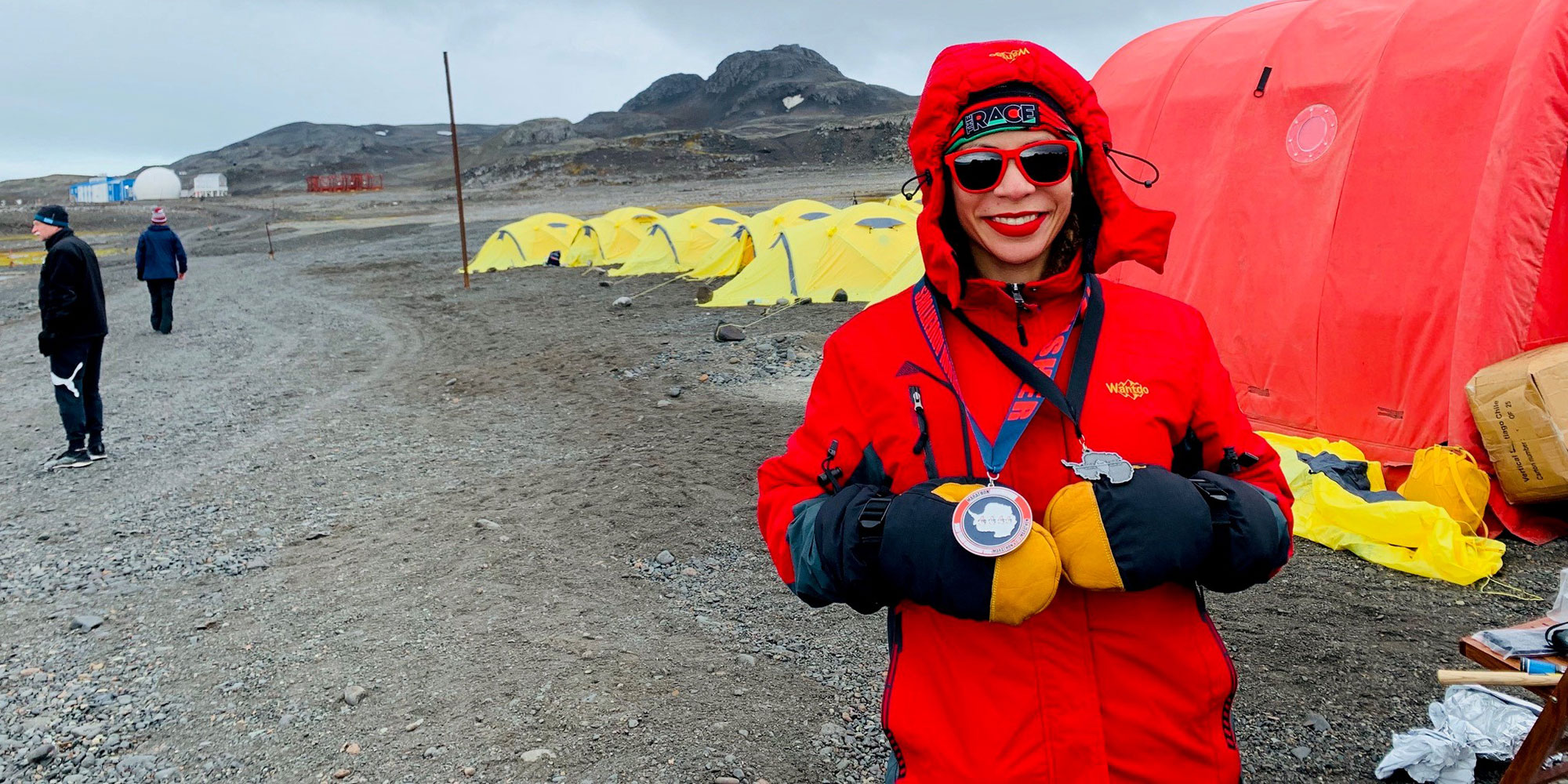Karen Warren, an outdoor instructor at Hampshire College, has written about how media depicts women differently than men. That despite achievements by women and girls, the outdoors remains painted as a man’s domain.
She’s experienced firsthand the stigma those depictions create.
When Warren, 65, hiked Angel’s Landing in Utah’s Zion National Park in May 2019, onlookers cheered her on, shouting things like “you can do it” as she stepped along the trail’s rocky ridge. Upon finishing, a guy looked at her and exclaimed: “You made it!”
“I’m thinking the whole time: ‘I knew I was going to make it,’” she said. “It made me feel frustrated.”
The media helps create these stereotypes, Warren says. Whether it’s the idea that women participate in less-demanding outdoor activities or that women older than 50 can’t hack it outside, falsehoods spread through inaccurate depictions or a lack of representation. The latter is especially true. About 15 percent of all media images feature people older than 50, even though the age group comprises nearly half the population, according to AARP.
When publishers do feature women older than 50, Warren says, it’s because they’ve done something extraordinary: “If you are going to see women [above a certain age in outdoor media], it’s going to be the superwoman. It’s going to be the anomaly. It’s going to be this woman who broke all odds.”
Warren says women 50 and older tend to have less of a place in headlines, even when they’re participating as often as their younger counterparts. The disappearing act begins in their 50s or 60s.
“The reason [an older woman] is shown is because she’s exemplary,” Warren says. “It’s not because she’s an outdoor person. We’re all surprised because she can climb 5.12 or she can still make a first ascent at her age.”
Ultimately, this sends a strong message to these women: “It says, ‘you can’t do it,’” Warren says.
But many women are doing things outside—whether it’s learning to backpack, running races around the world or enjoying a weekly walk at the park. Here, five women from different decades share their personal outdoor stories, proving there’s no age limit on time outside.
Aprille Moore, 36, Atlanta, Georgia
Commitment over convenience. That’s the adage to which Aprille Moore subscribes. It perhaps explains how, in the past five years, she’s run five marathons, 19 half marathons and the equivalent of about nine marathons’ worth of smaller races. It explains how she began rising before the sun to join friends from Black Girls RUN! for early-morning jogs. And even how she discovered Black Girls RUN!, a group that allowed her to meet other runners like herself.
But Moore likes to remind people: Five years ago, she wasn’t a runner, and she certainly wasn’t a morning person.
Moore, a police officer, first considered the sport in 2015 when she joined one of her supervisors for a sub-two-mile run. Twenty-five yards in, she was winded. A year later, she tried again, running a 10K with her police chief. She performed all right, she says, but wanted to do better. She began running on her own, but soon began searching for a group of women to run with. “Most of my friends were like, ‘Run? Who’s getting up to run?’”
Eventually, Moore found Black Girls RUN! on Facebook. She felt intimidated by the group at first, and she jokes that she “stalked” them for months before finally committing to a run. When she finally did, it was a cold, 5am jog—cementing, in a way, her transition to becoming both a runner and a morning person.
“That was in February and by September I applied to be an ambassador, and I’ve been an ambassador ever since,” she says. Black Girls RUN! ambassadors volunteer time to organize runs and workshops, among other things. REI has supported the organization for the past several years, providing product trainings, financial support and gear donations, as well as partnering on campaigns such as Opt Outside.
Now Moore runs marathons in different countries and has set a personal goal to someday complete a race on every continent. Her most recent: Antarctica. In January, Moore traveled to the southernmost continent, where she raced on a course made from gravel, ice and mud she describes as being the consistency of “quicksand and peanut butter mixed together.” She ran through 15 mph winds in temperatures that dipped to a finger-numbing 18 degrees. Still, she ran. Over gravel that ranged in size from pebbles to cantaloupes. Past seals and penguins. Up a course that climbed about 3,000 feet.
“You couldn’t have told me five years ago that I would be getting up at 4 in the morning to go running at 5 with a group of women two or three times a week, or that I would be excited about doing long runs,” she says.
Moore has also used running as an antidote for unexpected challenges. When Moore divorced her husband more than a year ago, running helped her heal. “It was tough,” she says, but her moments of putting foot to pavement kept her sane. If she wanted to run off a bad day, she could. “The pavement is there. The woods are there. The trails are there. The parks are there,” she says.
These days, Moore runs up to 25 miles a week. Sometimes she’s preparing for an international race. Other times, she’s just jogging with friends, happy to be moving.
“It’s like taking a shot of caffeine. It really keeps me going throughout the day and gives me a sense of accomplishment,” she says. “I did something healthy that was for me. That didn’t require me to spend any money. It just required me to invest the time in myself.”
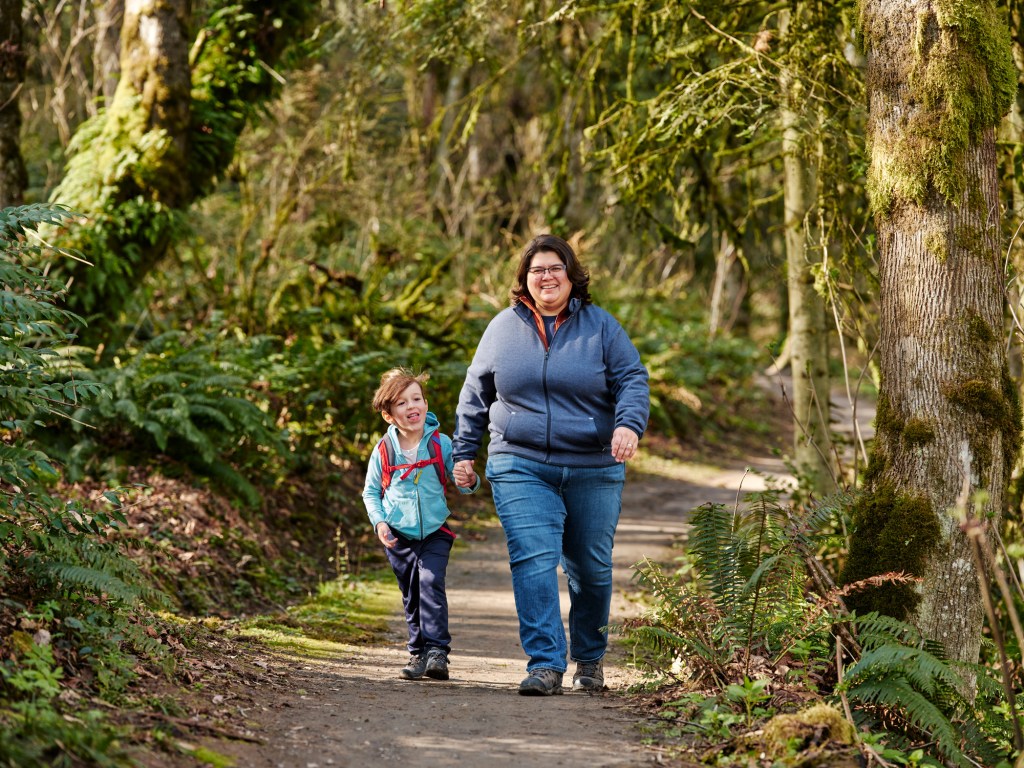
Brandy Pirtle-Guiney walks through Portland’s Forest Park with her son, Asher. (Photo Credit: Isaac Lane Koval)
Brandy Pirtle-Guiney, 42, Portland, Oregon
Brandy Pirtle-Guiney’s first camping trip 12 years ago came with its hiccups. She and her now wife, Elana Pirtle-Guiney, an REI member, picked out a spot along Oregon’s John Day River, a winding tributary that runs through muted-brown hills. They planned to cook over a campfire and take dips in the river. But an unexpected fire ban foiled half of those plans, and so they swapped warm camp food for cold hummus and trail mix. Even still, the trip piqued Pirtle-Guiney’s interest in embracing the outdoors.
“It was one of those great experiences where we had nothing else … and we had to really enjoy where we were and what we were doing,” she says.
Today, Pirtle-Guiney camps regularly at the coast with Elana Pirtle-Guiney and 4-year-old son, Asher. But even with this camping cred, Pirtle-Guiney hesitates to call herself an outdoorswoman. “I think I have a hard time with that because there are people who are so much more outdoorsy,” she says.
The hesitancy partly stems from not seeing many people like herself on the trail. The people advertised doing outdoor activities are typically “incredibly fit, white, young and economically well off,” she says. Pirtle-Guiney is of Mexican descent, and she doesn’t consider herself athletic.
“When I first started doing outdoorsy things, I felt like I was in someone else’s world versus doing something I had every right to do,” she says.
Those stereotypes have prompted her to qualify her outdoor time. She’s quick to note that she’s a fair-weather hiker (she prefers reading indoors when it’s raining), and that she’s not interested in backpacking or climbing. She says she doesn’t have nature in her bones the way her wife, Elana, does. And when she thinks of what it means to be outdoorsy, her mind drifts to a person scaling a rock wall. Still, Pirtle-Guiney heads outside often, enjoying Forest Park’s shade-cloaked trails that wind through Portland. Or trips to Oregon’s Rockaway Beach, which have become a favorite way to unplug from work.
But Pirtle-Guiney also talks about the homogeneity of the outdoors. It’s all too apparent to her, and she thinks it’s important to talk about it, knowing that if the outdoors were advertised differently, she might have adopted the space as her own sooner. Maybe she wouldn’t hesitate to call herself an outdoorswoman.
But she doesn’t identify as an outdoor advocate. Pirtle-Guiney has adopted this role in other areas; for instance, she’s a board member of the Pride Foundation, a LGBTQ+ advocacy organization in the Pacific Northwest. Her outdoor time, on the other hand, is just her outdoor time.
Even if she remains unsure about dubbing herself outdoorsy, she’s certain about one thing: She wants people to discover a place outside, and she wants them to do it sooner than she did.
“I would love to make somebody’s journey to the outdoors faster than mine was.”
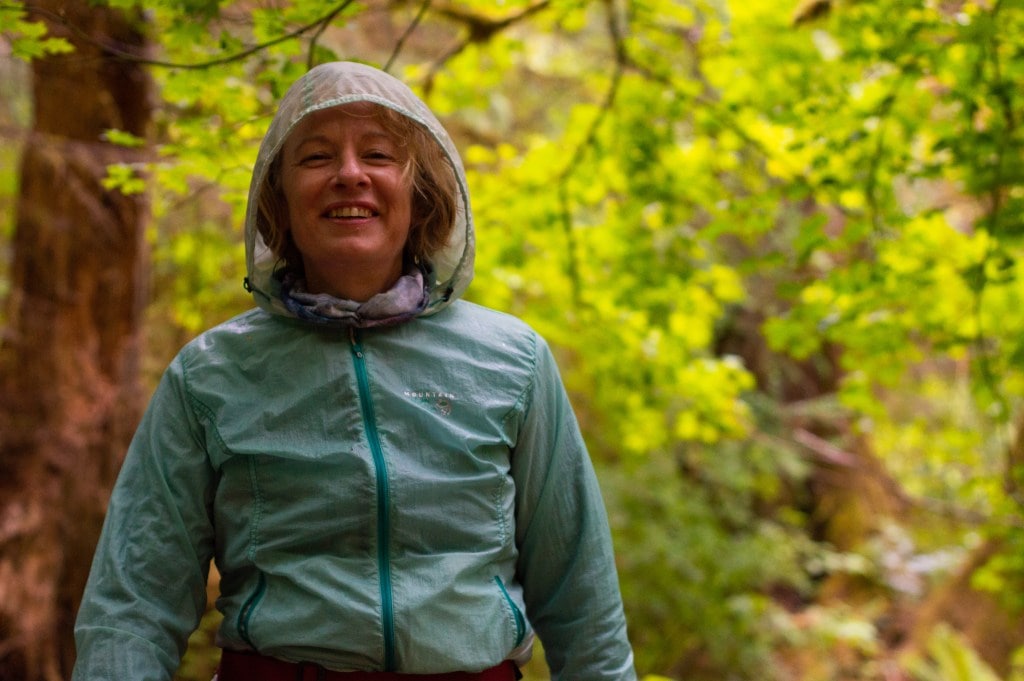
Joanne Baste pictured on a recent hike. (Photo credit: Alma Baste)
Joanne Baste, 53, Washington, D.C. metro area
Assessing a new bouldering problem isn’t REI member Joanne Baste’s lone challenge when climbing. She occasionally grapples with her ego on the rock wall, too.
Many of her partners are 20 years her junior and climb with the vigor of someone who doesn’t worry about getting hurt. But that’s not Baste, who’s a little more conservative in her approach.
“It’s hard on your ego sometimes,” Baste says. “Should I use my age as an excuse? Is it just an excuse?”
In other ways, Baste has gained confidence from climbing. She better understands what her body can do and is more at peace with her identity outdoors. “I am more, just, me,” she says.
This means she’s OK with the fact that she prefers paddling through alligator-inhabited swamps over navigating aggressive white water. And that she’s fine admitting she’d rather climb a vertical wall than strap on a pair of skis.
“I don’t have to be any particular kind of outdoorsy person to be me,” she says.
But there’s still pressure. She began climbing around 2010 in her mid-40s, taking up the sport just before her daughter moved away for college. Soon after, she became inspired to begin hiking trails near her home, taking her young pitbull mix Canela with her.
“It can be intimidating to start something new,” she says.
Baste remembers a trip in 2015 when she went sport climbing in West Virginia’s Franklin Gorge with a friend and fellow climber. She says she’s not as sure-footed as some of her friends, and she quickly began doubting whether she could finish the climb. But trying something new is like making a move on a wall: You have to commit.
“You either have to down climb, or you need to make that move,” she says.
The sport has also taught her to quiet the voices telling her she can’t.
“I think the thing that rock climbing has taught me more than anything is just how much is in your head that stops you,” she says. “You can do a lot.”
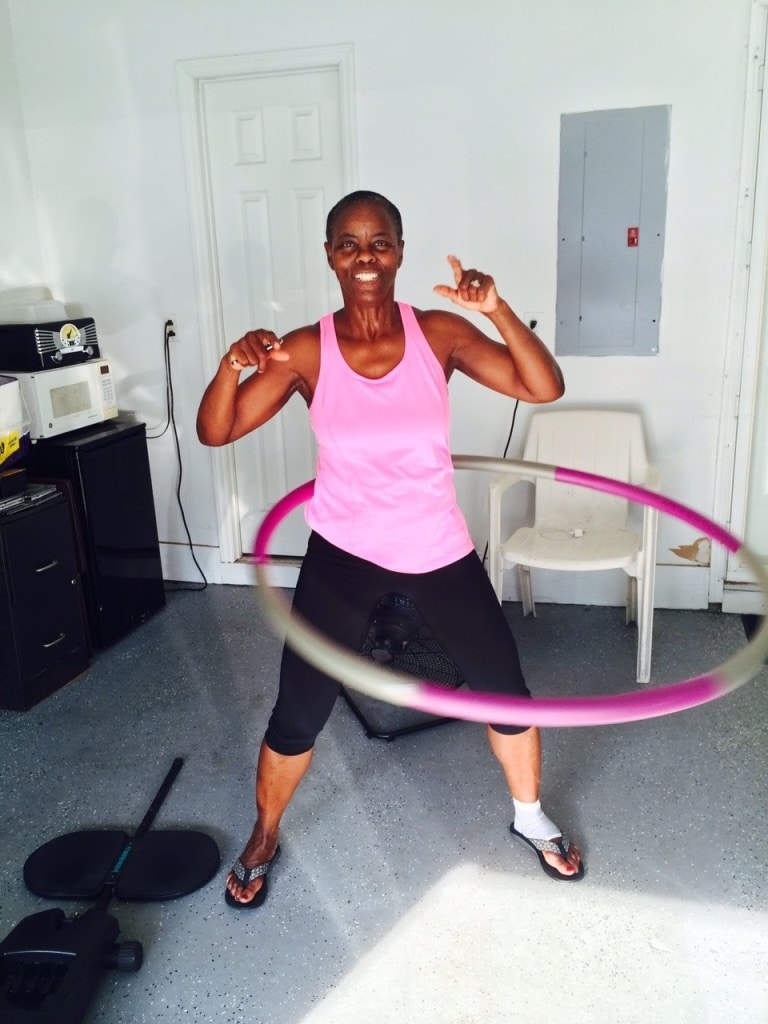
Millie Anderson enjoys one of her favorite activities outside of running: hula hooping. (Photo Courtesy: Millie Anderson)
Millie Anderson, 64, Charleston, South Carolina
Millie Anderson likes to move. She bikes, cycles, hula hoops and runs. She dances and does chair yoga. She jokes that if she feels she’s been sitting too long, she’ll jump up to do some jumping jacks.
“My husband looks at me like: ‘she has lost her mind,’” she says, letting out a loud laugh.
But Anderson is serious about moving, even if her tone is light. She wants to keep her body as sharp as her mind, and her favorite way to do that is by running or walking outside. Raised on a South Carolina farm, outdoor time is part of her life’s fabric. She craves it.
At home, she’ll open doors and crack windows to invite a cool breeze. Sometimes she’ll retreat to the open garage or her porch to relax in the sun. When she began running six years ago, it was a new way to fill up on fresh air. She started with walks that turned into slow jogs that morphed into 5Ks and 10Ks. A year and a half into it, she ran her first marathon. She says she’s more active today than she was in her 30s when she was raising three children. But she’s always taken time for herself, and that time has always involved being outside.
“I’m not an indoor person,” she emphasizes.
When Anderson first became interested in running, she started with slow walks. She’d meander for 10 minutes near her home. She remembers worrying that she was traveling too far from her neighborhood, and she’d become anxious. But soon the routine became a familiar and wanted part of her day.
It’s kept her healthy. “I actually feel 30,” she says. Like Moore, Anderson joined Black Girls RUN! to find a group of running partners. She says the group encourages her to continue running, and she inspires them in return. “It’s not about running. It’s about moving,” she says.
Of course, everyone needs a rest, and Anderson says she takes two or three days off a week for recovery. But after that, she’s off again, not ready to slow down any time soon.
“My head tells me, ‘You’re old. You need to sit down somewhere.’ I’m like nah, not today.”
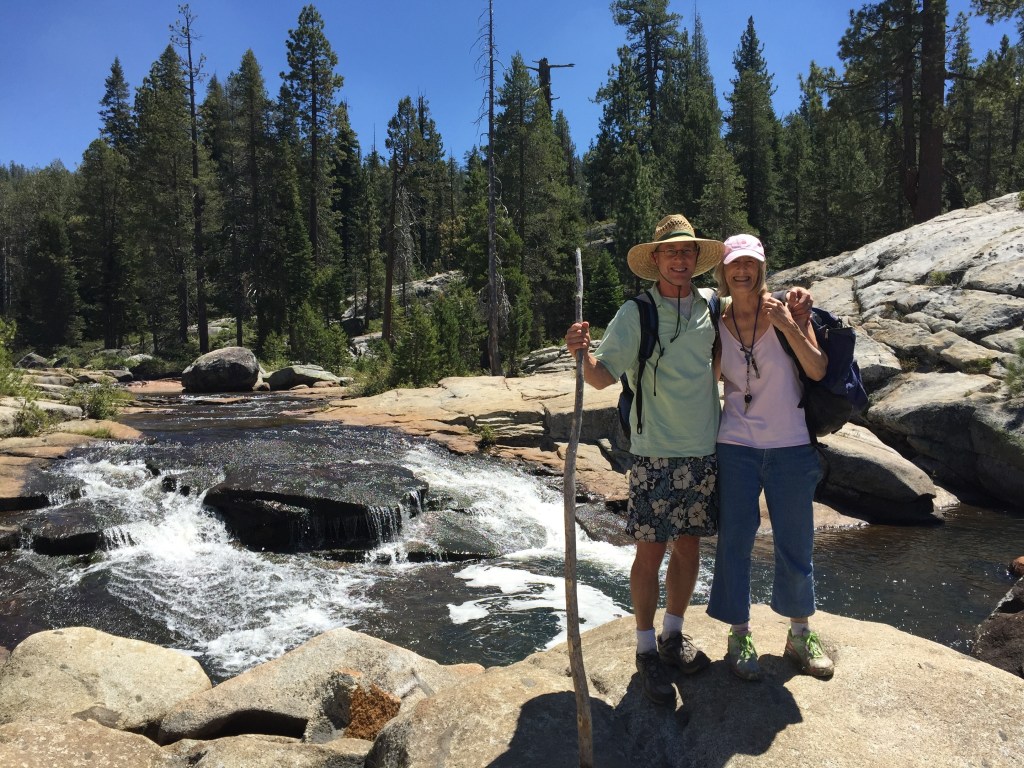
Kathy Carroll pictured on a hike with her brother in 2015. (Photo Courtesy: Kathy Carroll)
Kathy Carroll, 72, San Francisco Bay Area
About a year ago, REI member Kathy Carroll decided to start backpacking.
Shortly after, she began researching gear and training differently at the gym, swapping aerobics for weights. One afternoon last summer, she filled a daypack with two 10-pound weights and headed to a trail near her home. The paved, gently sloping path was the perfect testing ground for carrying the weight, which she someday plans to shoulder in the form of gear on a much longer trek.
Carroll made the decision to learn to backpack after reading about the mental health benefits of outdoor time. She wants to remain sharp and strong and being outside interests her. She spent her 20s running marathons and chasing two sons, but now she wants to witness a backcountry sunset. She even plans to use the skills on an eventual solo road trip to the Midwest, where her late mother grew up, and camp at state parks along the way.
As with anything new, Carroll finds backpacking daunting. “[I’m] not exactly in limbo, but I’m at a place where I’m looking for how I’m going to go in the direction I want to go with it,” she says
Though backpacking is novel, outdoor time isn’t. Her mother regularly shooed her and her siblings into the yard to play when they were children. By the day’s end, the kids would retreat indoors to rinse dirt from their soft feet. By summer’s end, their skin had calloused from the daily play. In her 30s and 40s, Carroll took up jogging leaf-lined trails near her home, able to devour as many as 10 miles before breakfast. Even when it rained, she’d trot through the drizzle.
“There was nobody else out there, but I would still be out there because I liked being out in the rain,” she says.
Still, Carroll didn’t entertain camping or backpacking until she retired in 2015. She married a man who didn’t know much about the backcountry. Together, they took their sons on resort vacations, only hiking occasionally. Carroll camped some as a child, but it was primarily out of necessity: Her family would spend summers exploring cities by day and sleep in campsites at night to save money.
“We didn’t think of [camping] as ‘Oh, I’m going to go be in nature,’” she says. “We would camp outside [the city] in this campground with all these other people, and then we would get dressed every day and go … be tourists.”
As she prepares for her own adventure, Carroll also reads, losing herself in memoirs written by women who have hiked mileage she plans to walk. The minimalist in her prevents her from keeping physical copies of many books, but she’s permitted herself two: 101 Great Hikes of the San Francisco Bay Area and 60 Hikes Within 60 Miles. Soon, she may buy another: Backpacking 101.
Carroll doesn’t yet have advice for women who want to go backpacking for the first time. She’s still figuring it out herself, through her training, gear browsing and researching.
However, she does have a request for other women: “Call me. Email me. Let’s go.”
And Beyond
Spending time outside doesn’t end in your 70s just as it doesn’t begin in your 30s. Moore, Pirtle-Guiney, Baste, Anderson and Carroll are just a few of the women spending time outside in a way that makes sense to them.
Is there an outdoorswoman who inspires you? Share a story about this person in the comments below.
